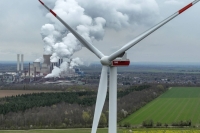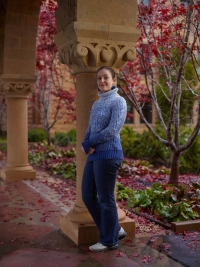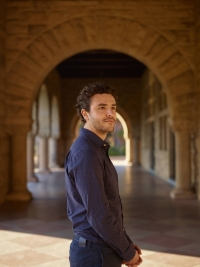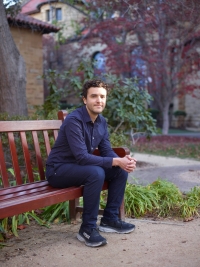Two good friends, Rebecca Grekin and Yannai Kashtan, met up one crisp December morning at Stanford University, where they both study and teach. The campus was deserted for the holidays, an emptiness at odds with the school’s image as a place where giants roam, engaged in groundbreaking research on heart transplants, jet aerodynamics, high-performance computing — work that has changed the world.
Grekin and Kashtan are young climate researchers. I had asked them there to explain how they hoped to change the world themselves.
They have very different ideas about how to do that. A big question: What role should money from oil and gas — the very industry that’s the main contributor to global warming— have in funding work like theirs?
"I’m just not convinced we need fossil fuel companies’ help,” said Kashtan, 25, as we toured the lab where he works, surrounded by sensitive electronic gear used to detect methane. "The forces and the incentives are aligned in the wrong direction. It makes me very cynical.”
For Grekin, 26, that’s a delicate issue. Her entire academic career, including her doctoral work at Stanford, has been funded by Exxon Mobil.
"I know people who are trying to change things from the inside,” she said. "I’ve seen change.”
We spent hours that day — first at her lab, then in his, and then off campus at a hole-in-the-wall Burmese joint — as the two disagreed and agreed in amiable and insistent ways about some of the biggest questions facing the next generation of climate scientists like themselves.
Should universities accept climate funding from the very companies whose products are heating up the planet? Is it better to work for change from within a system or from outside? How much should the world count on cutting-edge technologies that seem far-fetched today?
And the big one: What is gained or lost when oil producers fund climate solutions?
Some of Grekin’s research has focused on calculating the true climate impact of food and other things that people consume. In the hallway outside her lab hangs a large poster describing her work. The poster prominently features the ExxonMobil logo.
"They brag about their relationship with Stanford, their association with bright, young, environmentally minded scientists,” Kashtan said, standing in the hallway. "But the majority of their money is going to things that are pretty explicitly about getting more oil out of the ground.”
Grekin pushed back on any suggestion that Exxon had influenced her research. The poster was simply being transparent about her funding, she said, which is always appropriate. "You’re supposed to share your funding sources,” she said. "They don’t have anything to do with the research. They just happen to fund graduate school.”
In any case, her work is already being used at 40 universities to cut the climate impact of their sprawling food services, she pointed out. Would that have happened otherwise?
Despite differences like these, Kashtan and Grekin are friends. They fill in to teach each other’s classes. They both talk passionately about solutions to climate change, and both co-signed an open letter last year calling on Stanford to establish guidelines for engaging with fossil fuel companies.
Kashtan said his skepticism about oil-industry motivations was born of his own experience. A physics and chemistry double-major working on his doctorate, he previously researched a technology called electrofuels that big corporations, including fossil fuel companies, are promoting as a way to fight global warming.
The technology behind electrofuels, also known as e-fuels, sounds equal parts science fiction and magic.
It essentially involves capturing carbon dioxide, the greenhouse gas that is rapidly warming the planet, by sucking it out of the air, then combining it with hydrogen that has been split from water (using renewable energy) to make liquid fuels that can be used in trucks and planes. Startups working on e-fuels, including a Stanford spinoff, have raised millions of dollars, typically from the venture capital arms of large oil and gas companies, as well as from airlines.
But Kashtan has come to believe that deploying e-fuels at scale isn’t just many years away; it also doesn’t make sense from an economic or even energy perspective. For one, he said, capturing carbon dioxide by pulling it out of the atmosphere is itself energy-intensive. The rest of the process to produce the fuel, even more so.
Instead, these technologies have become industry-funded red herrings that distract from the critical task of burning less fossil fuels, he said. After all, it is the burning of coal, oil and gas that’s putting the planet-warming gases in the air in the first place.
He’s come to be particularly wary of how well-meaning colleagues, like his friend Grekin, could play a role in bringing about that delay — for example, by amplifying research that emphasizes far-out technological solutions instead of, say, taking steps like curbing emissions.
Technologies like electrofuels aren’t simply "complete wastes of time, talent and money,” Kashtan said in his characteristically direct way; "they’re exactly what fossil fuel companies want.”
We were in Kashtan’s lab, filled with tubes, tanks and ozone scrubbers. The team he’s part of was working on a project to measure air pollution from gas-burning stoves in homes across the world. It wasn’t what he expected to be researching. Since he was a child growing up in Oakland, California, he’s been interested in the possibilities of technology, not the harms of it.
As a boy, he produced a series of YouTube videos earnestly explaining every element of the periodic table. "That’s pure Beryllium metal right there: super toxic, super hard, pretty expensive and one of my favorite elements,” 12-year-old Yannai says in one clip, decked out in goggles and lab coat.
Grekin disputed Kashtan’s notion of new technologies as delay tactics. That approach raised the risk that the world would write off promising innovations prematurely, she said. "Sometimes you don’t know until you do the research,” she said.
"Do we need people focusing on these problems so that we can find either better solutions” or cheaper solutions, Grekin asked. "Yes. Do we know exactly what those will be? No.”
"But I see an exception when it comes to climate, because of the timeline,” Kashtan said. "We’re racing against the clock here.”
"Maybe I’m more optimistic about the future, and Yannai, maybe, is less,” Grekin said.
We were starving and decided to look for lunch. The only option on the all-but-empty campus was a sad Starbucks. So instead, we drove to a Burmese restaurant, a local favorite, snagging a table outside so that we could hear one another better.
On the way, Grekin was apologetic about driving us in her car, a bright yellow Fiat 500 that she’s had for more than a decade, instead of walking or taking a bus. Usually, she doesn’t drive, she said. It was just that she’d brought several weeks’ worth of recycling to drop off that day, one of the few permissible excuses for a climate researcher to drive to campus in a car, in her view.
"I came with my entire car full of recycling,” she said.
Grekin said she also tries to buy very little. "This is from high school. Like, a lot of my clothes are from high school,” she said.
In response, Kashtan pointed to his own shirt. "This is a hand-me-down,” he said.
Fossil fuel funding for research has become a thorny issue for many universities, and particularly at Stanford’s Doerr School. Founded in 2022 with a $1.1 billion gift by John Doerr, a venture capitalist and billionaire, the school quickly attracted criticism for saying it would work with and accept donations from fossil fuel companies.
A recently issued list of funders of the Doerr School is a who’s who of the fossil fuel industry
In October, a nonprofit group founded by Adam McKay, the writer and director of "Don’t Look Up,” the climate-themed film starring Jennifer Lawrence and Leonardo DiCaprio, criticized the Doerr School in a satirical ad that has since been viewed more than 200,000 times on X, formerly known as Twitter. "The school seeks to come up with ways to combat climate change, so we’re calling on the help of all our friends at Big Oil,” the parody says.
Stanford has been a friend to oil and gas in the past. A researcher at the Stanford Exploration Project, which began in the 1970s, later developed an algorithm for BP that contributed to a 200-million-barrel oil and gas discovery in the Gulf of Mexico.
Today, many of these older programs are atrophying, and some are shutting down. A project that worked with oil and gas companies to study the geology of undersea drill sites off the coast of West Africa ended in 2022.
Stanford’s newer fossil fuel-funded programs instead tend to focus on climate solutions, like blue hydrogen or carbon storage. Kashtan questions the climate bona fides of many of those programs.
The Natural Gas Initiative, for example, works with an industry consortium to research ways that natural gas can be part of the climate solution. It is led by a former Chevron strategist, and industry funders get a spot on its board of advisers for $250,000 a year.
"They’re ultimately about how to drill more efficiently,” he said.
"Exxon did offer me internships that were basically like, ‘Let’s get more oil out of the ground more efficiently,’” Grekin said. "But I didn’t want to do that,” she said. "So I fought really hard and got an internship that was sustainability-related.”
She feels that her current research, into ways to make heating and air-conditioning systems in commercial buildings more efficient, wouldn’t have been possible without Exxon, which made an entire office building in Houston available to her for experimentation. Her Exxon funding also paid for a recent stint in the Amazon rainforest back in Brazil, where she helped teach a course about sustainable polymers and locally sourced materials.
"The way I see it is, if this money wasn’t coming to me, it could be going toward a new drill, a new rig,” she said.
Can these two friends reach a compromise? They say they did find common ground hammering out proposed guidelines on how Stanford should engage with fossil fuel companies.
The guidelines include a call for eliminating financial sponsorships from any company, trade group or organization that doesn’t have a credible plan for transitioning away from fossil fuels to renewable power, doesn’t provide transparent data or is otherwise at odds with goals set forth under the Paris accord, the landmark 2015 agreement among the nations of the world to fight climate change.
"In my opinion, all of the fossil fuel companies currently funding Stanford research would be pretty much disqualified,” Kashtan said. "The only thing that’s going to prompt these companies to shift is either being sued into bankruptcy, or some kind of economic or regulatory pressure, not partnerships with universities.”
Grekin looked taken aback. "I’d like to think that we don’t have to go to those extremes,” she said.
An Exxon spokesperson said the company was "investing billions of dollars into real solutions.” She added, "Research and healthy debate by students like Rebecca and Yannai are critical to developing solutions that will help us all.”
A spokesperson for the Doerr School said, "We are proud of our students for engaging in civil discourse on this topic, and we are listening.”
The conversation stretched on. We ordered more tea. We ended up overstaying our welcome at the Burmese restaurant.
"Maybe I’m naive,” Grekin said as we wrapped up the day. She recalled a moment from one of her early Exxon internships, near its sprawling refinery in Baytown, Texas, when she "looked up, and there was this huge ball of flame coming out of a flare,” she said, referring to the towering, flaming stacks that are a dramatic feature of refineries. In that moment, she said, she felt her work on sustainability insignificant, her effect on reducing emissions even smaller than what that flare was emitting that very second.
She now thinks differently. "If I can change Exxon by even 1%,” she said, "the impact I have might make up for more than that flare.”
This article originally appeared in The New York Times © 2025 The New York Times Company



























With your current subscription plan you can comment on stories. However, before writing your first comment, please create a display name in the Profile section of your subscriber account page.